Search the Blog
Categories
- Books & Reading
- Broadband Buzz
- Census
- Education & Training
- General
- Grants
- Information Resources
- Library Management
- Nebraska Center for the Book
- Nebraska Memories
- Now hiring @ your library
- Preservation
- Pretty Sweet Tech
- Programming
- Public Library Boards of Trustees
- Public Relations
- Talking Book & Braille Service (TBBS)
- Technology
- Uncategorized
- What's Up Doc / Govdocs
- Youth Services
Archives
Subscribe
Category Archives: Information Resources
November Health Outreach Resources
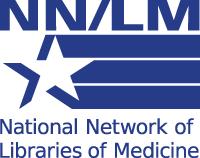
November is …
- National Family Health History Month
- National American Indian Heritage Month
- American Diabetes Month
The National Network of Libraries of Medicine has just released resources to help you plan health programs and promote health information during November. Links include a program kit, webinars, electronic bulletin slides, posters, and social media materials. Visit this page for more details: https://nnlm.gov/all-of-us/national-health-observances#toc-9.
Healthfinder.gov offers a toolkit for American Diabetes Month. The toolkit provides ideas for hosting a community event, and resources to share health information through your website, newsletter, or social media. Visit this page for more details: https://healthfinder.gov/NHO/NovemberToolkit.aspx.
Christian Minter, MSLIS
Community Engagement and Health Literacy Librarian
Coordinator of Circulation Services
Assistant Professor
McGoogan Library of Medicine
University of Nebraska Medical Center
986705 Nebraska Medical Center | Omaha, NE 68198-6705
402-559-7226
christian.minter@unmc.edu
Rural Nebraska Communities have Access to $2.2 Million for Disaster Recovery Due to FEMA-Major Disaster Declarations
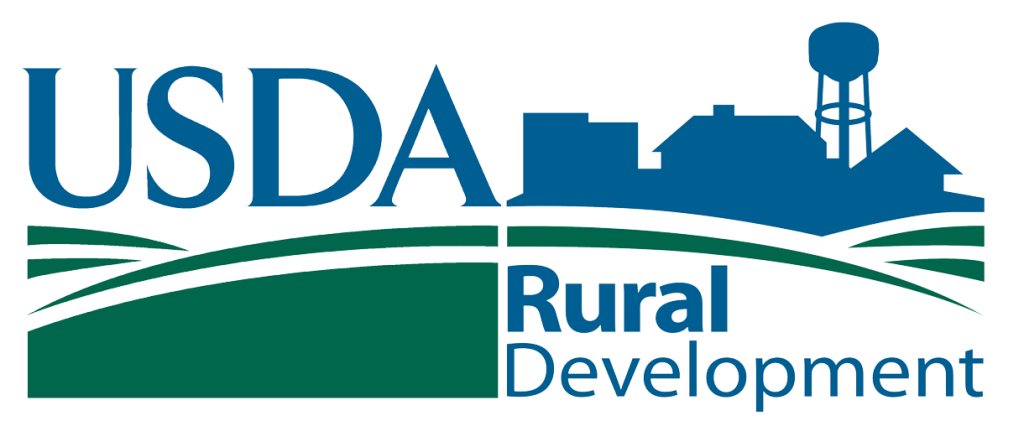
Lincoln, Neb., Oct. 22, 2019 – U.S. Department of Agriculture (USDA) Rural Development Nebraska State Director Karl Elmshaeuser announced that Nebraska has been allocated with nearly $2.2 million in grants available through the Community Facilities Program to help rural communities continue in their recovery from the devastating effects of FEMA declared disasters in Nebraska.
“Nebraska has been hit hard by the devastating weather, with 83 of our counties receiving Major Disaster Declarations,” Elmshaeuser said. “USDA works hard to help communities thrive and this funding supports in their long-term recovery.”
The $2.2 million is included in the Additional Supplemental Appropriations for Disaster Relief Act that President Trump signed into law on June 6, 2019.
Nebraska declared counties are: Adams, Antelope, Banner, Blaine, Boone, Box Butte, Boyd, Brown, Buffalo, Burt, Butler, Cass, Cedar, Cherry, Cheyenne, Clay, Colfax, Cuming, Custer, Dakota, Dawes, Dawson, Deuel, Dixon, Dodge, Douglas, Fillmore, Franklin, Frontier, Furnas, Gage, Garden, Garfield, Gosper, Greeley, Hall, Hamilton, Harlan, Holt, Howard, Jefferson, Johnson, Kearney, Keith, Keya Paha, Kimball, Knox, Lancaster, Lincoln, Logan, Loup, Madison, Merrick, Morrill, Nance, Nemaha, Nuckolls, Omaha Indian Reservation, Otoe, Pawnee, Phelps, Pierce, Platte, Polk, Ponca TDSA, Richardson, Rock, Sac and Fox Indian Reservation, Saline, Santee Indian Reservation, Sarpy, Saunders, Scotts Bluff, Seward, Sheridan, Sherman, Stanton, Thayer, Thomas, Thurston, Valley, Washington, Wayne, Webster, Wheeler, Winnebago Indian Reservation, and York.
Grant applications will be accepted at USDA Rural Development Attn: Community Programs; 100 Centennial Mall North; Federal Building Room 308; Lincoln, Neb. 68508. Applications will be accepted on a continual basis until funds are exhausted. Grant assistance will be provided on a graduated scale; smaller communities with the lowest median household income are eligible for a higher proportion of grant funds. For application details and additional information, see page 47477 of the Sept. 10 Federal Register. In Nebraska, contact your local Rural Development Community Program Staff.
More than 100 types of projects are eligible for Community Facilities funding. Eligible applicants include municipalities, public bodies, nonprofit organizations and federally recognized Native American tribes.
Projects must be in eligible rural areas with a population of 20,000 or less.
In April 2017, President Donald J. Trump established the Interagency Task Force on Agriculture and Rural Prosperity to identify legislative, regulatory and policy changes that could promote agriculture and prosperity in rural communities. In January 2018, Secretary Perdue presented the Task Force’s findings to President Trump. These findings included 31 recommendations to align the federal government with state, local and tribal governments to take advantage of opportunities that exist in rural America. Increasing investments in rural infrastructure is a cornerstone recommendation of the task force.
To view the report in its entirety, please view the Report to the President of the United States from the Task Force on Agriculture and Rural Prosperity (PDF, 5.4 MB). In addition, to view the categories of the recommendations, please view the Rural Prosperity infographic (PDF, 190 KB).
USDA Rural Development provides loans and grants to help expand economic opportunities and create jobs in rural areas. This assistance supports infrastructure improvements; business development; housing; community facilities such as schools, public safety and health care; and high-speed internet access in rural areas. For more information, visit www.rd.usda.gov.
*USDA is an equal opportunity provider, employer and lender.
The Census and Special Districts in the U.S.
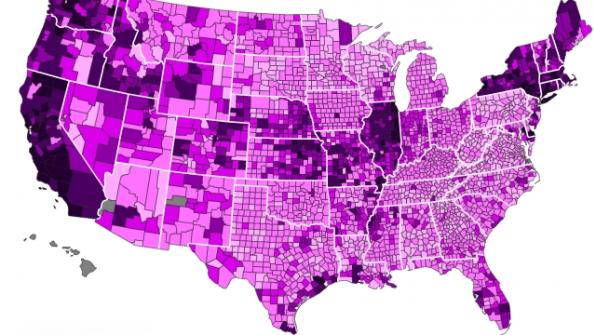
From Municipalities to Special Districts, Official Count of Every Type of Local Government is in the 2017 Census of Governments.
We know what counties and municipalities are. But what are special districts?
Special districts are independent government units created for a limited, specific purpose and, every year, new districts are created and existing ones dissolve.
The latest in-depth, encyclopedic count of special districts and all types of local governments in the United States is now available.
Released earlier this year, the U.S. Census Bureau’s 2017 Census of Governments Organization component provides statistics on governments in the United States as of June 2017 and shows changes since the last count in 2012.
Tables show counts by government type, state, population-size groups, function and school systems.
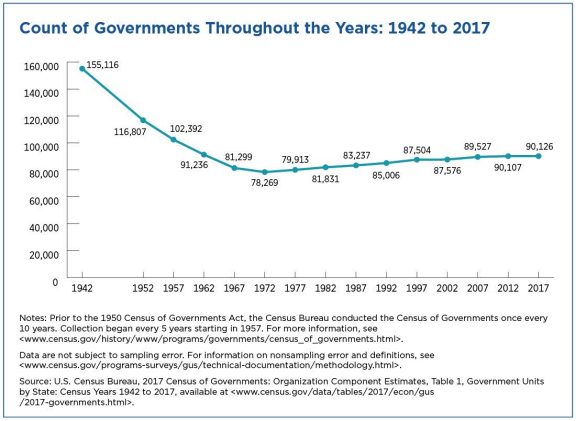
Local governments are classified into five types: county, municipal, township, special districts and school districts.
County, municipal and township governments are general-purpose governments. The official count for those types of governments has not changed significantly since 2012.
Then there are special districts.
They typically have a shorter lifespan and higher turnover than general purpose governments, but the difference in their counts was also relatively slim between 2012 and 2017: The 2017 Census of Governments added more than 1,500 special districts and removed roughly 1,260 that are no longer operating.
Nebraska Examples of Special Districts
Airport Authorities, Cemetery Districts, Community Building Districts, County Fair Boards, Drainage Districts, Hospital Districts and Authorities, Housing Agencies, Interstate County Bridge Commissions, Irrigation Districts, Joint Electric Power, Sewerage and Solid Waste Disposal, Water Distribution Agencies—1981 Law, Joint Public Power Authorities—1982 Law, Metropolitan Transit Authority, Metropolitan Utilities Districts, Natural Resources Districts, Public Power Districts, Reclamation Districts, Risk Management Pools, Road and Street Improvement Districts—1957 and 1961 Laws, Rural and Suburban Fire Protection Districts, Rural Water Districts, and Sanitary and Improvement Districts.
Why So Many New Special Districts?
So why are states creating special districts these days?
In some cases, states create them to provide services to newly- developed geographic areas.
In other cases, the special purpose activity or services already exist, but residents expect a higher level of quality.
For example, a state may have fire protection services. However, the established governmental structure may not legally allow the fire district to raise enough funds to maintain the desired level of quality services.
That’s when a state may choose to create a special district. Most special districts can levy additional property or sales taxes, and may borrow money to buy or build facilities by issuing bonds.
Some districts are only active for a limited time, usually as long as it takes to pay back a debt.
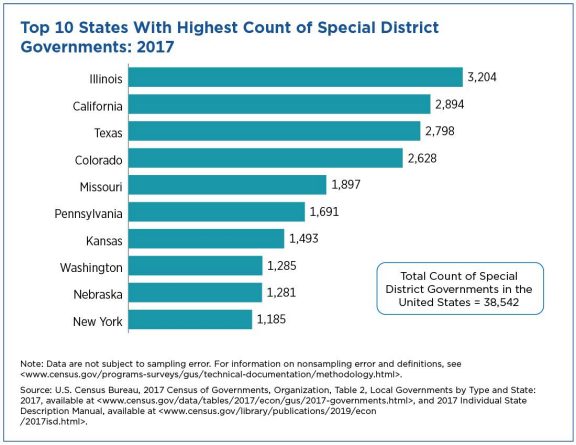
Multifunction Districts
Between the 2012 and 2017 census, multifunction districts grew the most.
Multifunction districts can collect property taxes and issue tax-exempt bonds. Legislation authorizing multifunction districts was passed in most states across the nation in the 1980s.
For example:
- In Colorado, the 2017 Census of Governments added close to 270 metropolitan districts to the master list of local governments in the state.
Metropolitan districts can provide a wide array of services, such as fire protection, street improvements, recreation, mosquito control and television relay services.
These districts can collect property taxes and issue public debt. That’s why it’s important to keep track of public funds controlled by these districts.
Most of the metropolitan districts in Colorado are development districts created to provide funding for development projects.
- In Texas, multifunction districts, called Municipal Utility Districts (MUDs), also showed growth. The 2017 Census of Governments added nearly 200 units to the master list of local governments in Texas.
MUDs provide a variety of utility services in areas not included in a municipality. These districts can finance developing infrastructure and housing.
MUDs can incur public debts in the form of bonds to finance infrastructure and/or housing, and may dissolve in 15 to 25 years after the debt is paid in full.
As in Colorado, developers who see public-private partnerships as business opportunities usually drive the creation of multifunction districts.
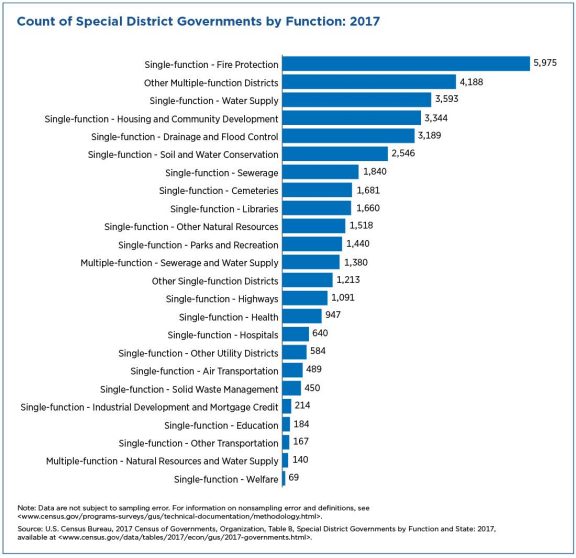
Development And Water Supply Districts
Financing capital improvement was the leading force behind special district growth in Florida.
The 2017 Census of Governments added about 130 new Community Development Districts (CDD). In Florida, CDDs may finance a variety of community development projects, such as new sewage facilities.
The 2017 Individual State Descriptions publication provides a comprehensive description of the governmental organization for the 50 states and the District of Columbia.
Some of these districts are similar to Community Improvement Associations (CIAs) in size and scale of operations. Both are a result of the housing boom from 2003 to 2008.
The major difference is that CDDs are considered public government units that enjoy some tax exemptions, although this comes with other regulations and required transparency in governing these districts.
The 2017 Census of Governments data also reflect the creation of more water supply districts in New Mexico. Over 150 Mutual Domestic Water Consumers Associations were included as special district governments since the last census. Other states, including California, Arkansas, Missouri and Washington, also added between 10 to 20 water supply districts.
Fire And Emergency Services Districts
Nationally, Emergency Services Districts (ESD) that provide local fire protection and ambulance services have grown this decade: 150 were created from 2012 to 2017 — 130 of them in Texas.
The increase is centered in areas experiencing the fastest population growth in the country since the 2010 Census.
Often, ESDs are organized as a funding tool for existing volunteer fire departments. These allow volunteer fire districts to collect additional property and sales taxes to provide service to their expanding communities.
It can be challenging to find fire-fighting funding in areas losing population and experiencing declining property values.
In Arizona, for example, laws passed in 2013 allow fire districts to consolidate into fire authorities to reduce overhead costs. The 2017 Census of Governments shows 14 new joint fire authorities in Ohio.
Some township volunteer fire departments have recently begun to combine personnel, equipment and property tax revenue to become official special district governments.
Another way districts can improve emergency response and rescue operations is by creating Emergency Communications (911) Districts to help coordinate resources between municipalities, counties and other local governments.
Some states, including Texas, Iowa, and Oregon, have had them since 1985. Others like Washington and Massachusetts have recently introduced laws enabling citizens to create 911 districts.
Download the Individual State Descriptions: 2017 Census of Governments
A History of the Census in the United States : Part 3
The 3rd Census: Census Day was August 6, 1810
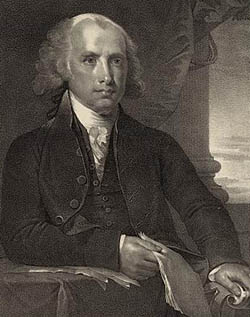
Authorizing Legislation
The authorization act for the third census stipulated that an assistant marshal must actually visit each household, or the head of each family, within his designated enumeration district and should not rely on hearsay or the like to complete his count. The act also mandated that the enumeration commence on the first Monday of August.
Enumeration
An act of May 1, 1810 amended the earlier authorizing legislation to require that, while they were collecting demographic data, assistant marshals also collect available economic data. These men recorded the “several manufacturing establishments and manufactures within their several districts, territories, and divisions.” The marshals transmitted the manufacturing data to the secretary of the treasury at the same time they sent the results of the population enumeration to the secretary of state. No schedule was prescribed for the collection of industrial data and the nature of the inquiries were at the discretion of the secretary of the treasury. Because of this, the collection of manufacturing data was so erratic that it was generally considered useless except to identify broad industrial trends.
Intercensal Activity
An act of May 16, 1812, provided for the publication of a digest of manufactures containing data on the kind, quality, and value of goods manufactured, the number of establishments, and the number of machines of various kinds used in certain classes of manufactures. The report containing incomplete returns for more than 200 kinds of goods and including several items that were principally agricultural, was published in 1813.
Further Information
- A wide variety of historical statistics from this and other decades is available in Historical Statistics of the United States: Colonial Times to 1970. It is available as a PDF [74.4MB] or 2-part ZIP file: Part I [52.2MB] | Part II [66.1MB].
- Reports and statistics from the 1810 census
- History and Growth of the United States Census: 1790-1890 [PDF 117MB], by Carroll D. Wright and William C. Hunt.
Information provided from Census.gov
E-rate @ West Point
Have you registered for the upcoming E-rate workshops? In person workshops are still open for Grand Island (October 28), and Ashland (November 12). Registration information can be found here:
Don’t worry if you miss (the workshop that is), as you can always register or view the online session. It’s the E-rate you don’t want to miss out on. You can also make it a full day and attend the afternoon Digital World session. For more information about the impact of E-rate, check out this week’s Adobe Spark video. Like the others, this was created using all free resources. This week’s story is from the John Stahl Public Library in West Point:
[youtube https://www.youtube.com/watch?v=bVLf0S283Z8&w=560&h=315]A History of the Census in the United States : Part 2
The 2nd Census: Census Day was August 4, 1800
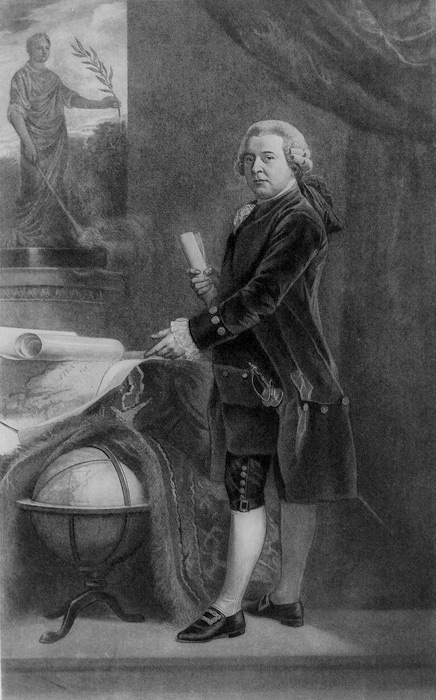
Authorizing Legislation
An act of February 28, 1800 authorized the second census of the United States, which was to include the states and territories northwest of the Ohio River and Mississippi Territory. The census was to conclude within nine calendar months of its start.
The guidelines for the 1800 enumeration followed those of the first census, with only minor alterations in the law. John Marshall, secretary of state in 1800, was the nominal head of census operations. By early 1801, however, Marshall was chief justice of the Supreme Court. James Madison, his successor as secretary of state, oversaw the final tabulations and reported population totals to Congress and the president.
Enumeration
The questionnaire provided space to separately tally free white males and females in several age categories: under 10, 10 but under 15, 16 but under 25, 25 but under 45, and over 45. Indians, slaves, and free blacks were listed in single categories undivided into age groups.
Further Information
- A wide variety of historical statistics from this and other decades is available in Historical Statistics of the United States: Colonial Times to 1970. It is available as a PDF [74.4MB] or 2-part ZIP file: Part I [52.2MB] | Part II [66.1MB].
- History and Growth of the United States Census: 1790-1890 [PDF 117MB], by Carroll D. Wright and William C. Hunt.
Information provided from Census.gov
Jobs Available for the 2020 Census!
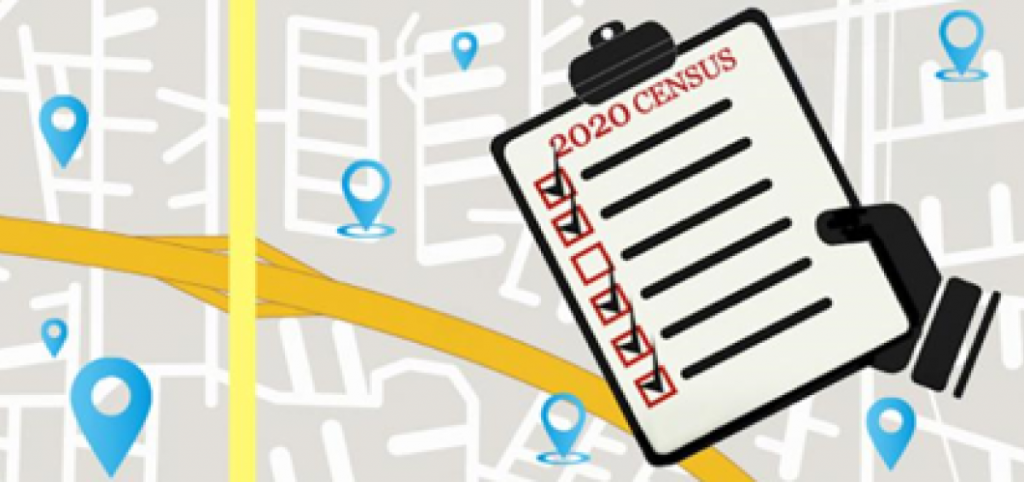
The week of October 21st is Jobs Week for the 2020 Census! Anyone can apply!
The posters below can be printed out and placed anywhere in your library!
Visit 2020 Census Jobs for more information!
Posted in Census, Education & Training, General, Information Resources, Uncategorized, What's Up Doc / Govdocs
Tagged census
Leave a comment
A History of the Census in the United States : Part 1

The First Census: Census Day was August 2, 1790.
Authorizing Legislation
The first census began more than a year after the inauguration of President Washington and shortly before the second session of the first Congress ended. Congress assigned responsibility for the 1790 census to the marshals of the U.S. judicial districts under an act which, with minor modifications and extensions, governed census taking through 1840. The law required that every household be visited, that completed census schedules be posted in “two of the most public places within [each jurisdiction], there to remain for the inspection of all concerned…” and that “the aggregate amount of each description of persons” for every district be transmitted to the president.
Enumeration
The six inquiries in 1790 called for the name of the head of the family and the number of persons in each household of the following descriptions:
- Free White males of 16 years and upward (to assess the country’s industrial and military potential)
- Free White males under 16 years
- Free White females
- All other free persons
- Slaves
Under the general direction of Thomas Jefferson, the Secretary of State, marshals took the census in the original 13 States, plus the districts of Kentucky, Maine, and Vermont, and the Southwest Territory (Tennessee).
Both George Washington and Thomas Jefferson expressed skepticism over the final count, expecting a number that exceeded the 3.9 million inhabitants counted in the census.
Further Information
- A wide variety of historical statistics from this and other decades is available in Historical Statistics of the United States: Colonial Times to 1970. It is available as a PDF [74.4MB] or 2-part ZIP file: Part I [52.2MB] | Part II [66.1MB].
- Publications and population statistics from the 1790 census
- History and Growth of the United States Census: 1790-1890 [PDF 117MB], by Carroll D. Wright and William C. Hunt
Information provided from Census.gov.
What’s Up Doc? New State Agency Publications at the Nebraska Library Commission
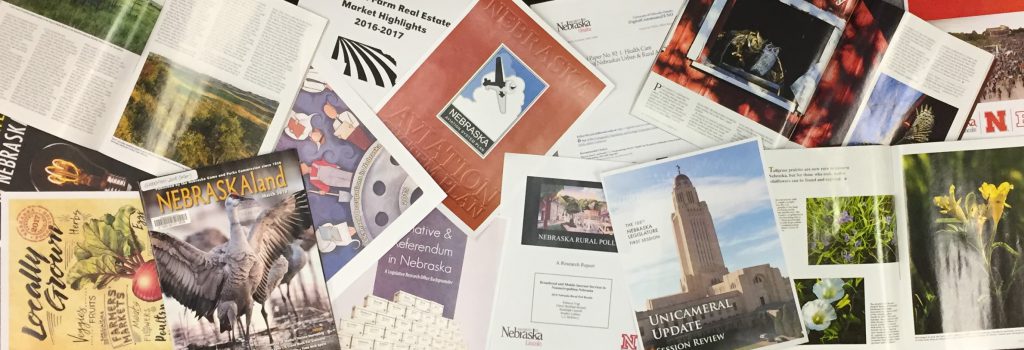
New state agency publications have been received at the Nebraska Library Commission for September 2019. Included are reports from the Nebraska Auditor of Public Accounts, the Nebraska Information Technology Commission, the Nebraska Oil and Gas Conservation Commission, the Nebraska Department of Natural Resources, and new books from the University of Nebraska Press, to name a few.
Most items, except the books from the University of Nebraska Press, are available for immediate viewing and printing by clicking on the highlighted link above, or directly in the .pdf below. You can read synopses of the books received from the University of Nebraska Press books in the September Book Briefs blogpost.
The Nebraska Legislature created the Nebraska Publications Clearinghouse in 1972, a service of the Nebraska Library Commission. Its purpose is to collect, preserve, and provide access to all public information published by Nebraska state agencies. By law (State Statutes 51-411 to 51-413) all Nebraska state agencies are required to submit their published documents to the Clearinghouse. For more information, visit the Nebraska Publications Clearinghouse page, contact Mary Sauers, Government Information Services Librarian; or contact Bonnie Henzel, State Documents Staff Assistant.
E-rate Story
Special thanks to those public librarians who recently completed our technology and E-rate survey. As of today, we have received over 200 responses. While we are working on analyzing the results, here’s a little 2 minute video (see below), with special thanks to the Pawnee City Public Library. FREE tools were used to create this video using Adobe Spark. If you are interested in learning more about E-rate, consider attending one of the upcoming workshops:
October 21, 2019 – Columbus (Central Community College)
October 28, 2019 – Grand Island Public Library
November 5 – Online via GoToWebinar
The video has sound, so make sure to turn yours on. Here you go:
[youtube https://www.youtube.com/watch?v=tZr3hWzA3ME&w=560&h=315]
Call for Speakers: Big Talk From Small Libraries 2020
The Call for Speakers for Big Talk From Small Libraries 2020 is now open!
 This free one-day online conference is aimed at librarians from small libraries; the smaller the better! We are looking for speakers from small libraries or speakers who directly work with small libraries. Small libraries of all types – public, academic, school, museum, special, etc. – are encouraged to submit a proposal. We’re looking for seven 50-minute presentations and five 10-minute “lightning round” presentations.
This free one-day online conference is aimed at librarians from small libraries; the smaller the better! We are looking for speakers from small libraries or speakers who directly work with small libraries. Small libraries of all types – public, academic, school, museum, special, etc. – are encouraged to submit a proposal. We’re looking for seven 50-minute presentations and five 10-minute “lightning round” presentations.
Do you offer a service or program at your small library that other librarians might like to hear about? Have you implemented a new (or old) technology, hosted an event, partnered with others in your community, or just done something really cool? The Big Talk From Small Libraries online conference gives you the opportunity to share what you’ve done, while learning what your colleagues in other small libraries are doing. Here are some possible topics to get you thinking:
- Unique Libraries
- Special Collections
- New buildings
- Fundraising
- Improved Workflows
- Staff Development
- Advocacy Efforts
- Community Partnerships
- That great thing you’re doing at your library!
Big Talk From Small Libraries 2020 will be held on Friday, February 28, 2020 between 8:45 a.m. and 5:00 p.m. (CT) via the GoToWebinar online meeting service. Speakers will be able to present their programs from their own desktops. The schedule will accommodate speakers’ time-zones.
If you are interested in presenting, please submit your proposal by Friday, January 3, 2020.
Speakers from libraries serving fewer than 10,000 people will be preferred, but presentations from libraries with larger service populations will be considered.
This conference is organized and hosted by the Nebraska Library Commission and is co-sponsored by the Association for Rural & Small Libraries.
Book Briefs: New University of Nebraska Press Books at the Nebraska Publications Clearinghouse
 The Nebraska Publications Clearinghouse receives documents every month from all Nebraska state agencies, including the University of Nebraska Press (UNP). Each month we will be showcasing the UNP books that the Clearinghouse receives. UNP books, as well as all Nebraska state documents, are available for checkout by libraries and librarians, for their patrons, in Nebraska.
The Nebraska Publications Clearinghouse receives documents every month from all Nebraska state agencies, including the University of Nebraska Press (UNP). Each month we will be showcasing the UNP books that the Clearinghouse receives. UNP books, as well as all Nebraska state documents, are available for checkout by libraries and librarians, for their patrons, in Nebraska.
Here are the UNP books the Clearinghouse received in September:
 An Army in Crisis : Social Conflict and the U.. Army in Germany, 1968-1975 Alexander Vazansky
An Army in Crisis : Social Conflict and the U.. Army in Germany, 1968-1975 Alexander Vazansky
Following the decision to maintain 250,000 U.S. troops in Germany after the Allied victory in 1945, the U.S. Army had, for the most part, been a model of what a peacetime occupying army stationed in an ally’s country should be. The army had initially benefited from the positive results of U.S. foreign policy toward West Germany and the deference of the Federal Republic toward it, establishing cordial and even friendly relations with German society. By 1968, however, the disciplined military of the Allies had been replaced with rundown barracks and shabby-looking GIs, and U.S. bases in Germany had become a symbol of the army’s greatest crisis, a crisis that threatened the army’s very existence.
In An Army in Crisis Alexander Vazansky analyzes the social crisis that developed among the U.S. Army forces stationed in Germany between 1968 and 1975. This crisis was the result of shifting deployment patterns across the world during the Vietnam War; changing social and political realities of life in postwar Germany and Europe; and racial tensions, drug use, dissent, and insubordination within the U.S. Army itself, influenced by the civil rights movement, the Vietnam War, and the youth movement in the States. With particular attention to 1968, An Army in Crisis examines the changing relationships between American and German soldiers, from German deference to familiarity and fraternization, and the effects that a prolonged military presence in Germany had on American military personnel, their dependents, and the lives of Germans. Vazansky presents an innovative study of opposition and resistance within the ranks, affected by the Vietnam War and the limitations of personal freedom among the military during this era.
 Bodies Built for Game : The Prairie Schooner Anthology of Contemporary Sports Writing Edited by Natalie Diaz; Hannah Ensor, Associate Editor
Bodies Built for Game : The Prairie Schooner Anthology of Contemporary Sports Writing Edited by Natalie Diaz; Hannah Ensor, Associate Editor
Sport has always been central to the movements of both the nation-state and the people who resist that nation-state. Think of the Roman Colosseum, Jesse Owens’s four gold-medal victories in the 1936 Nazi Olympics, Kareem Abdul-Jabbar’s protest at the 1968 Olympics, and the fallout Colin Kaepernick suffered as a result of his recent protest on the sidelines of an NFL game. Sport is a place where the body and the mind are the most dangerous because they are allowed to be unified as one energy.
Bodies Built for Game brings together poems, essays, and stories that challenge our traditional ideas of sport and question the power structures that athletics enforce. What is it that drives us to athletics? What is it that makes us break our own bodies or the bodies of others as we root for these unnatural and performed victories? Featuring contributions from a diverse group of writers, including Hanif Abdurraqib, Fatimah Asghar, Reginald Dwayne Betts, Louise Erdrich, Toni Jensen, Ada Limón, Tommy Orange, Claudia Rankine, Danez Smith, and Maya Washington, this book challenges America by questioning its games.
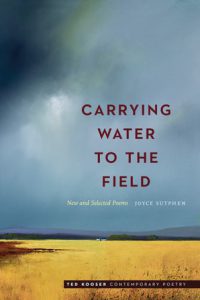 Carrying Water to the Field : New and Selected Poems Joyce Sutphen; Introduction by Ted Kooser (Series: Ted Kooser Contemporary Poetry Series)
Carrying Water to the Field : New and Selected Poems Joyce Sutphen; Introduction by Ted Kooser (Series: Ted Kooser Contemporary Poetry Series)
Joyce Sutphen’s evocations of life on a small farm, coming of age in the late 1960s, and traveling and searching for balance in a very modern world are both deeply personal and familiar. Readers from Maine to Minnesota and beyond will recognize themselves, their parents, aunts and uncles, and neighbors in these poems, which move us from delight in keen description toward something like wisdom or solace in the things of this world.
In addition to poems selected from the last twenty-five years, Carrying Water to the Field includes more than forty new poems on the themes of luck, hard work, and the ravages of time—erasures that Sutphen attempts to ameliorate with her careful attention to language and lyrical precision.
 The Distance Between : A Memoir Timothy J. Hillegonds
The Distance Between : A Memoir Timothy J. Hillegonds
At eighteen years old, with no high school diploma, a growing rap sheet, and a failed relationship with his estranged father, Timothy J. Hillegonds took a one-way flight from Chicago to Colorado in hopes of leaving his mounting rage and frustration behind. His plan was simple: snowboard, hang out, live an uncomplicated life.
The Distance Between chronicles how Hillegonds’s plan went awry after he immediately jumped head first into a turbulent relationship with April, a Denny’s coworker and single mother. At once passionate and volatile, their relationship was fueled by vodka, crystal methamphetamine, and poverty—and it sometimes became violent. Mere months after moving to the mountains, when the stakes felt like they couldn’t be higher, Hillegonds learned April was pregnant with his child.
More than just a harrowing story of addiction and abuse or a simple mea culpa, The Distance Between is a finely wrought exploration of, and reckoning with, absent fathers, fatherhood, violence, adolescent rage, white male privilege, and Hillegonds’s own toxic masculinity. With nuance and urgency, The Distance Between takes readers through the grit of life on the margins while grappling with the problematic nature of one man’s existence.
 Edith Wharton, Willa Cather, and the Place of Culture Julie Olin-Ammentorp
Edith Wharton, Willa Cather, and the Place of Culture Julie Olin-Ammentorp
Edith Wharton and Willa Cather wrote many of the most enduring American novels from the first half of the twentieth century, including Wharton’s The House of Mirth, Ethan Frome, and The Age of Innocence, and Cather’s O Pioneers!, My Ántonia, and Death Comes for the Archbishop. Yet despite their perennial popularity and their status as major American novelists, Wharton (1862–1937) and Cather (1873–1947) have rarely been studied together. Indeed, critics and scholars seem to have conspired to keep them at a distance: Wharton is seen as “our literary aristocrat,” an author who chronicles the lives of the East Coast, Europe-bound elite, while Cather is considered a prairie populist who describes the lives of rugged western pioneers. These depictions, though partially valid, nonetheless rely on oversimplifications and neglect the striking and important ways the works of these two authors intersect.
The first comparative study of Edith Wharton and Willa Cather in thirty years, this book combines biographical, historical, and literary analyses with a focus on place and aesthetics to reveal Wharton’s and Cather’s parallel experiences of dislocation, their relationship to each other as writers, and the profound similarities in their theories of fiction. Julie Olin-Ammentorp provides a new assessment of the affinities between Wharton and Cather by exploring the importance of literary and geographic place in their lives and works, including the role of New York City, the American West, France, and travel. In doing so she reveals the two authors’ shared concern about the culture of place and the place of culture in the United States.
 Gothic Queer Culture : Marginalized Communities and the Ghosts of Insidious Trauma Laura Westengard (Series: Expanding Frontiers: Interdisciplinary Approaches to Studies of Women, Gender, and Sexuality)
Gothic Queer Culture : Marginalized Communities and the Ghosts of Insidious Trauma Laura Westengard (Series: Expanding Frontiers: Interdisciplinary Approaches to Studies of Women, Gender, and Sexuality)
In Gothic Queer Culture, Laura Westengard proposes that contemporary U.S. queer culture is gothic at its core. Using interdisciplinary cultural studies to examine the gothicism in queer art, literature, and thought—including ghosts embedded in queer theory, shadowy crypts in lesbian pulp fiction, monstrosity and cannibalism in AIDS poetry, and sadomasochism in queer performance—Westengard argues that during the twentieth and twenty-first centuries a queer culture has emerged that challenges and responds to traumatic marginalization by creating a distinctly gothic aesthetic.
Gothic Queer Culture examines the material effects of marginalization, exclusion, and violence and explains why discourse around the complexities of genders and sexualities repeatedly returns to the gothic. Westengard places this queer knowledge production within a larger framework of gothic queer culture, which inherently includes theoretical texts, art, literature, performance, and popular culture.
By analyzing queer knowledge production alongside other forms of queer culture, Gothic Queer Culture enters into the most current conversations on the state of gender and sexuality, especially debates surrounding negativity, anti-relationalism, assimilation, and neoliberalism. It provides a framework for understanding these debates in the context of a distinctly gothic cultural mode that acknowledges violence and insidious trauma, depathologizes the association between trauma and queerness, and offers a rich counterhegemonic cultural aesthetic through the circulation of gothic tropes.
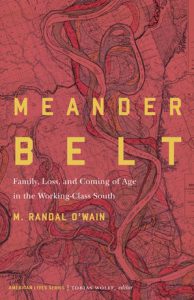 Meander Belt : Family, Loss, and Coming of Age in the Working-Class South M. Randal O’Wain (Series: American Lives)
Meander Belt : Family, Loss, and Coming of Age in the Working-Class South M. Randal O’Wain (Series: American Lives)
In Meander Belt M. Randal O’Wain offers a reflection on how a working-class boy from Memphis, Tennessee, came to fall in love with language, reading, writing, and the larger world outside of the American South. This memoir examines what it means for the son of a carpenter to value mental rather than physical labor and what this does to his relationship with his family, whose livelihood and sensibility are decidedly blue collar. Straining the father-son bond further, O’Wain leaves home to find a life outside Memphis, roaming from place to place, finding odd jobs, and touring with his band. From memory and observation, O’Wain assembles a subtle and spare portrait of his roots, family, and ultimately discovers that his working-class upbringing is not so antithetical to the man he has become.
 Salvific Manhood : James Baldwin’s Novelization of Male Intimacy Ernest L. Gibson III (Series: Expanding Frontiers: Interdisciplinary Approaches to Studies of Women, Gender, and Sexuality)
Salvific Manhood : James Baldwin’s Novelization of Male Intimacy Ernest L. Gibson III (Series: Expanding Frontiers: Interdisciplinary Approaches to Studies of Women, Gender, and Sexuality)
Salvific Manhood foregrounds the radical power of male intimacy and vulnerability in surveying each of James Baldwin’s six novels. Asserting that manhood and masculinity hold the potential for both tragedy and salvation, Ernest L. Gibson III highlights the complex and difficult emotional choices Baldwin’s men must make within their varied lives, relationships, and experiences. In Salvific Manhood, Gibson offers a new and compelling way to understand the hidden connections between Baldwin’s novels. Thematically daring and theoretically provocative, he presents a queering of salvation, a nuanced approach that views redemption through the lenses of gender and sexuality.
Exploring how fraternal crises develop out of sociopolitical forces and conditions, Salvific Manhood theorizes a spatiality of manhood, where spaces in between men are erased through expressions of intimacy and love. Positioned at the intersections of literary criticism, queer studies, and male studies, Gibson deconstructs Baldwin’s wrestling with familial love, American identity, suicide, art, incarceration, and memory by magnifying the potent idea of salvific manhood. Ultimately, Salvific Manhood calls for an alternate reading of Baldwin’s novels, introducing new theories for understanding the intricacies of African American manhood and American identity, all within a space where the presence of tragedy can give way to the possibility of salvation.
**All synopses courtesy of University of Nebraska Press (https://www.nebraskapress.unl.edu/)
BookFace Friday: You Were Always Mine, by Nicole Baart

When I was asked to read one of the books for this year’s Nebraska Book Festival, I immediately jumped at the chance to read You Were Always Mine, by Nicole Baart. As an adoptee from more than 50 years ago, I have wondered what my birth mother might have been like, as well as wondered about the adoption process. Nicole Baart has done an excellent job exploring a thriller scenario involving a birth mother, and it is definitely a can’t-put-it-down page-turner!
Iowa school teacher Jess Chamberlain, the heroine of this harrowing domestic thriller, and her husband, Evan, a family practitioner, have been separated for six months, and it’s been hard on their 13-year-old son, Max, and their six-year-old adopted son, Gabe. When Evan is killed in a hunting accident in Minnesota, Jess is shocked and suspicious, especially since Evan didn’t hunt. With the support of her family and friends, Jess struggles to move on from the death of a man she still loved. As Jess attempts to retrace Evan’s steps leading up to what becomes increasingly clear was his murder, she discovers that Evan was communicating with Gabe’s birth mother and may have been onto something that hits very close to home. Heartbreaking letters and emails sent by Gabe’s birth mother to various others, including Gabe, add emotional heft. Baart sensitively mines the bonds of motherhood and marriage while shining a light on a darker side of the adoption industry. (Publishers Weekly)
Don’t miss author Nicole Baart tomorrow at the Nebraska Book Festival!
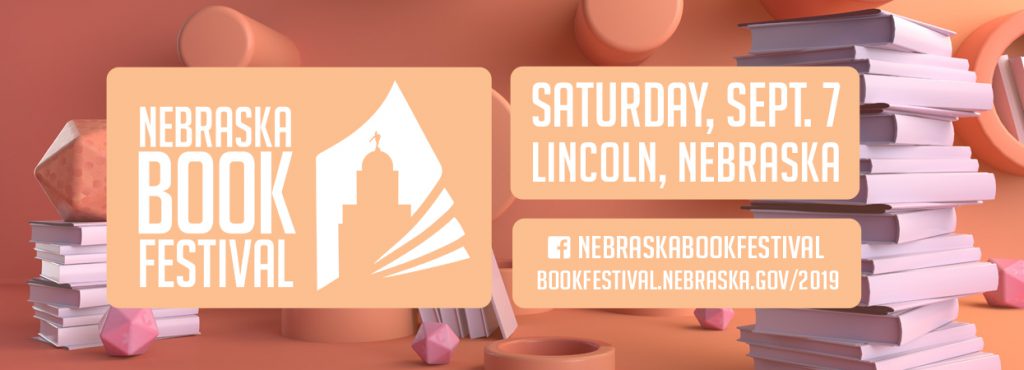
What’s Up Doc? New State Agency Publications at the Nebraska Library Commission

New state agency publications have been received at the Nebraska Library Commission for August 2019. Included are Annual Reports from a variety of Nebraska State Agencies, reports from the Nebraska Department of Correctional Services, reports relating to Economic Development from the Nebraska Public Power District, reports from the 106th Nebraska Legislature, and new books from the University of Nebraska Press, to name a few.
Most items, except the books from the University of Nebraska Press, are available for immediate viewing and printing by clicking on the highlighted link above, or directly in the .pdf below. You can read synopses of the books received from the University of Nebraska Press books in the August blogpost.
The Nebraska Legislature created the Nebraska Publications Clearinghouse in 1972, a service of the Nebraska Library Commission. Its purpose is to collect, preserve, and provide access to all public information published by Nebraska state agencies. By law (State Statutes 51-411 to 51-413) all Nebraska state agencies are required to submit their published documents to the Clearinghouse. For more information, visit the Nebraska Publications Clearinghouse page, contact Mary Sauers, Government Information Services Librarian; or contact Bonnie Henzel, State Documents Staff Assistant.
Book Briefs: New University of Nebraska Press Books at the Nebraska Publications Clearinghouse
 The Nebraska Publications Clearinghouse receives documents every month from all Nebraska state agencies, including the University of Nebraska Press (UNP). Each month we will be showcasing the UNP books that the Clearinghouse receives. UNP books, as well as all Nebraska state documents, are available for checkout by libraries and librarians, for their patrons, in Nebraska.
The Nebraska Publications Clearinghouse receives documents every month from all Nebraska state agencies, including the University of Nebraska Press (UNP). Each month we will be showcasing the UNP books that the Clearinghouse receives. UNP books, as well as all Nebraska state documents, are available for checkout by libraries and librarians, for their patrons, in Nebraska.
Here are the UNP books the Clearinghouse received in August:
 Extinction Events [Stories]
Extinction Events [Stories]
Liz Breazeale (Series: Prairie Schooner Book Prize in Fiction)
In this collection of short stories, Liz Breazeale explores the connections between humans and the natural world by examining the processes and history of our planet. A myriad of extinction events large and small have ruptured the history of the earth, and so it is with the women of this book, who struggle to define themselves amid their own personal cataclysms and those igniting the world around them. They are a mother watching the islands of the world disappear one by one, a new bride using alien abduction to get closer to her estranged parent, a daughter searching for her mother among the lost cities of the world, a sister trying and failing to protect her mythical continent–obsessed brother.
Here extinction events come in all sizes and shapes: as volcanic eruptions and devastating plagues and meteor impacts, as estrangements and betrayals and losses. Dark, angry, and apocalyptic, Extinction Events is a compendium of all the ways in which life can be annihilated.
 Hard Damage
Hard Damage
Aria Aber (Series: Prairie Schooner Book Prize in Poetry)
Hard Damage works to relentlessly interrogate the self and its shortcomings. In lyric and documentary poems and essayistic fragments, Aria Aber explores the historical and personal implications of Afghan American relations. Drawing on material dating back to the 1950s, she considers the consequences of these relations—in particular the funding of the Afghan mujahedeen, which led to the Taliban and modern-day Islamic terrorism—for her family and the world at large.
Invested in and suspicious of the pain of family and the shame of selfhood, the speakers of these richly evocative and musical poems mourn the magnitude of citizenship as a state of place and a state of mind. While Hard Damage is framed by free-verse poetry, the middle sections comprise a lyric essay in fragments and a long documentary poem. Aber explores Rilke in the original German, the urban melancholia of city life, inherited trauma, and displacement on both linguistic and environmental levels, while employing surrealist and eerily domestic imagery.
 Low Mountains or High Tea : Misadventures in Britain’s National Parks
Low Mountains or High Tea : Misadventures in Britain’s National Parks
Steve Sieberson
When Steve Sieberson and his wife unexpectedly found themselves in Britain with an entire summer on their hands, they readily agreed to avoid the usual tourist attractions, opting instead for a road trip to the UK’s far-flung national parks. As they set out, however, he envisioned bracing days of energetic hillwalking, while she assumed they would relax in tearooms and cozy pubs.
Seldom planning more than a few days in advance, the two traversed the country in a rented Vauxhall, subjecting themselves to single-track lanes, diabolical signage, and whimsical advice from locals. They discovered a town called Mirthless, a place where cats’ eyes are removed, and a vibrating cottage, while at mealtimes they dove fearlessly into black pudding, Eton mess, and barely recognizable enchiladas. Meanwhile, after their initial attempts at hiking together nearly ended in disaster, Sieberson received dispensation to scramble alone to the highest point in each national park—as long as he was quick about it and left plenty of time for more sedentary pursuits. Low Mountains or High Tea dishes up the charms and eccentricities of rural Great Britain as seen through the eyes of two Americans who never really knew what was coming next.
 Midwestern Strange : Hunting Monsters, Martians, and the Weird in Flyover Country
Midwestern Strange : Hunting Monsters, Martians, and the Weird in Flyover Country
B.J. Hollars
Midwestern Strange chronicles B.J. Hollars’s exploration of the mythic, lesser-known oddities of flyover country. The mysteries, ranging from bipedal wolf sightings to run-ins with pancake-flipping space aliens to a lumberjack-inspired “Hodag hoax,” make this book a little bit X-Files, a little bit Ghostbusters, and a whole lot of Sherlock Holmes. Hollars’s quest is not to confirm or debunk these mysteries but rather to seek out these unexplained phenomena to understand how they complicate our worldview and to discover what truths might be gleaned by reexamining the facts in our “post-truth” era.
Part memoir and part journalism, Midwestern Strange offers a fascinating, funny, and quirky account of flyover folklore that also contends with the ways such oddities retain cultural footholds. Hollars shows how grappling with such subjects might fortify us against the glut of misinformation now inundating our lives. By confronting monsters, Martians, and a cabinet of curiosities, we challenge ourselves to look beyond our presumptions and acknowledge that just because something is weird, doesn’t mean it is wrong.
 Modern Sudanese Poetry : an Anthology
Modern Sudanese Poetry : an Anthology
Translated and edited by Adil Babiker, Forward by Matthew Shenoda (Series: African Poetry Book Series)
Spanning more than six decades of Sudan’s post-independence history, this collection features work by some of Sudan’s most renowned modern poets, largely unknown in the United States. Adil Babikir’s extensive introduction provides a conceptual framework to help the English reader understand the cultural context. Translated from Arabic, the collection addresses a wide range of themes—identity, love, politics, Sufism, patriotism, war, and philosophy—capturing the evolution of Sudan’s modern history and cultural intersections.
Modern Sudanese Poetry features voices as diverse as the country’s ethnic, cultural, and natural composition. By bringing these voices together, Babikir provides a glimpse of Sudan’s poetry scene as well as the country’s modern history and post-independence trajectory.
 Wilderness of Hope : Fly Fishing and Public Lands in the American West
Wilderness of Hope : Fly Fishing and Public Lands in the American West
Quinn Grover (Series: Outdoor Lives)
Longtime fly fisherman Quinn Grover had contemplated the “why” of his fishing identity before more recently becoming focused on the “how” of it. He realized he was a dedicated fly fisherman in large part because public lands and public waterways in the West made it possible. In Wilderness of Hope Grover recounts his fly-fishing experiences with a strong evocation of place, connecting those experiences to the ongoing national debate over public lands.
Because so much of America’s public lands are in the Intermountain West, this is where arguments about the use and limits of those lands rage the loudest. And those loudest in the debate often become caricatures: rural ranchers who hate the government; West Coast elites who don’t know the West outside Vail, Colorado; and energy and mining companies who extract from once-protected areas. These caricatures obscure the complexity of those who use public lands and what those lands mean to a wider population.
Although for Grover fishing is often an “escape” back to wildness, it is also a way to find a home in nature and recalibrate his interactions with other parts of his life as a father, son, husband, and citizen. Grover sees fly fishing on public waterways as a vehicle for interacting with nature that allows humans to inhabit nature rather than destroy or “preserve” it by keeping it entirely separate from human contact. These essays reflect on personal fishing experiences with a strong evocation of place and an attempt to understand humans’ relationship with water and public land in the American West.
The 2020 Census : Confidentiality, in English and Spanish
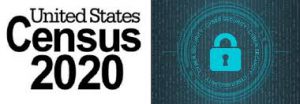 When you trust the Census Bureau with your information, their goal — and legal duty — is to keep it safe. Their mission is to serve as the nation’s leading provider of quality data about its people and economy. They couldn’t produce this information without you.
When you trust the Census Bureau with your information, their goal — and legal duty — is to keep it safe. Their mission is to serve as the nation’s leading provider of quality data about its people and economy. They couldn’t produce this information without you.
Their privacy principles guide their actions so that they respect your privacy and
protect your confidentiality.
• They do not identify individuals in the data
• They can only publish statistics.
• Their Disclosure Review Board verifies that any data product
we release meets our confidentiality standards.
From the beginning of the data collection process through the final storage of
information, they protect your data following industry best practices and federal
requirements. They use data encryption and two forms of authentication to secure
system access. The security of their systems is a top priority and they continually refine
their approach to address emerging threats.
The information bulletin below is available in English and Spanish, and can be printed out as a handout or a poster.
2020 Census : Four Ways to Respond
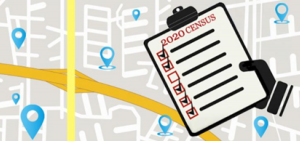 There are changes to the 2020 Census that will make it easier than ever for everyone to respond. The information bulletin below gives the 4 ways people can answer the Census questions, and can be printed out as a handout or a poster.
There are changes to the 2020 Census that will make it easier than ever for everyone to respond. The information bulletin below gives the 4 ways people can answer the Census questions, and can be printed out as a handout or a poster.
2020 Census : Counting Young Children, What You Need to Know
 The 2020 Census: Counting everyone once, only once, and in the right place.
The 2020 Census: Counting everyone once, only once, and in the right place.
An estimated 5% of kids under the age of 5 weren’t counted in the 2010 Census. That’s about 1 million young children, the highest of any age group. We need your help closing this gap in the 2020 Census. The information bulletin below tells us what research has discovered about why young children are missed and what you can do to help make sure they are counted. The information bulletin can be printed out as a handout, or as a poster:
Census 101 : What You Need to Know, in English and Spanish
 The 2020 Census is closer than you think! Here’s a quick refresher of what it is and why it’s essential everyone is counted.
The 2020 Census is closer than you think! Here’s a quick refresher of what it is and why it’s essential everyone is counted.
¡El censo del 2020 está más cerca de lo que piensas! A continuación te damos un
rápido repaso de lo que es y por qué es esencial que todos seamos contados
The information page below can be printed out as a handout or a poster:
Economic Census : What’s New For 2017 Data
The published data from the 2017 Economic Census will reflect many changes from the data that was published in the 2012 Economic Census. These changes mirror the ever-changing U.S. economy, communities, and data user needs. Below is a summary of these key changes and links to more information.
For a list of the data products for the 2017 Economic Census, see the high-level release schedule at: https://www.census.gov/programs-surveys/economic-census/about/release-schedules.html
Geographic Areas
The 2017 Economic Census will publish data to reflect the ever changing geographic areas as of January 2017. Reference materials that highlight the changes from the 2012 Economic Census will be provided on this site, including maps and documents that highlight the changes to:
- Metro Areas – the Core Based Statistical Areas in 15 states had some type of change
- Counties – Alaska, South Dakota, and Virginia had changes to 1 or more counties
- Economic Places – every state had places with area gain, loss, and/or code or name changes. There are 442 new Economic Places being recognized and 171 places that are being dropped for 2017, primarily due to population decline
NAICS
The 2017 Economic Census will be the first Census program to publish data on the 2017 North American Industry Classification System. 6 of the 18 sectors covered by the Economic Census will see changes to the codes published. These changes include:
- One-to-one recodes – industries with no content change but with a code change
- Many-to-one combinations – 2012 NAICS codes that were combined to form a new 2017 code
- Many-to-many combinations – 2 or more 2017 codes that were created from parts of 2 or more 2012 codes
NAPCS
A key offering from the Economic Census are the detailed Product Lines data, which provides a more detailed breakout of the products made and sold and services provided by businesses. These data from the 2012 Economic Census were provided in separate data tables by sector that provided different information. For the 2017 Economic Census, these data are being consolidated and reformatted following the new North American Product Classification System.
Other Changes
The data products from the 2017 Economic Census will include a number of structural and content changes. These include:
- The new “First Look” report – this new report will feature data not available in the initial “Advance Report” release in prior Economic Censuses.
- Consolidated “Size” reports – These data tables which provide detailed breakouts based on the employment and sales/revenue size of establishments or firms were published in separate and disparate tables by sector. For 2017, these tables are being consolidated and standardized across sectors.
- Added and dropped Miscellaneous Subjects reports – 38 tables from the 2012 Economic Census are being dropped, and 7 new tables are being added. Also, the tables showing data by Class of Customer, Enterprise Support, and Exported Services are similarly being consolidated.
- New disclosure rules – In prior Economic Censuses, the number of establishments was published even when the other statistics for an industry and geography were withheld due to disclosure. For 2017, new privacy rules will result in the establishment count being suppressed when less than 3 or when the other statistics are suppressed.
- Local areas published by sector – Place-level data will no longer be available for the Manufacturing sector and the NAICS and geographic levels published for other sectors may be adjusted based on data quality and privacy issues.
- New data.census.gov platform – the data tables from the 2017 Economic Census will be published on this new dissemination platform. Historical data from the 2012 Economic Census will continue to be available on American FactFinder under they are migrated to the new platform.


